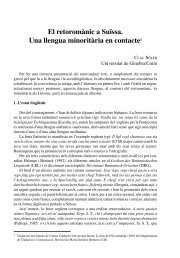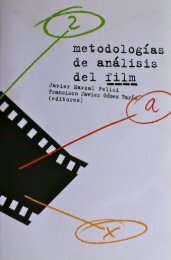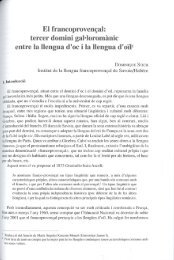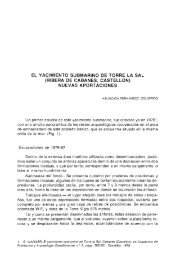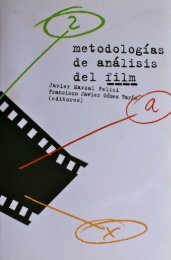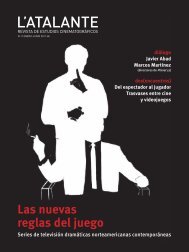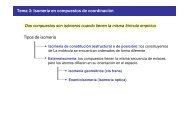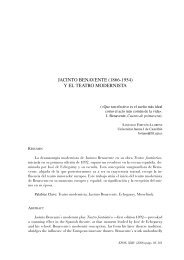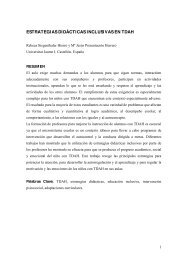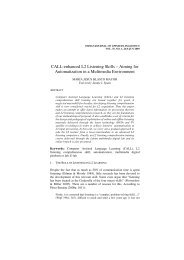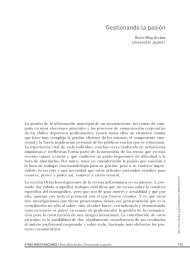Old Concepts, New Ideas: Approaches to ... - Repositori UJI
Old Concepts, New Ideas: Approaches to ... - Repositori UJI
Old Concepts, New Ideas: Approaches to ... - Repositori UJI
You also want an ePaper? Increase the reach of your titles
YUMPU automatically turns print PDFs into web optimized ePapers that Google loves.
old concePTs, new <strong>Ideas</strong>: aPPRoaches To<br />
TRanslaTIon shIfTs<br />
Lea Cyrus<br />
University of Münster<br />
abstract<br />
This paper traces the development of the translation shift concept from its origins<br />
in the linguistics-oriented era of translation studies <strong>to</strong> its current revival in computer-based<br />
approaches: after a presentation of the traditional approaches by John C.<br />
Catford, Jean-Paul Vinay and Jean Darbelnet, Eugene A. Nida, and Kitty van Leuven-<br />
Zwart, several recent studies that have integrated the concept of translation shifts<br />
are introduced and discussed. This comparison of old and new approaches reveals<br />
that the attitudes <strong>to</strong>wards shifts have changed from mildly prescriptive <strong>to</strong> neutrally<br />
descriptive. The paper concludes with a general evaluation of the place of linguistic<br />
approaches in translation studies.<br />
zusammenfassung<br />
Dieser Artikel untersucht die Entwicklung des Shift-Konzepts von seinen Ursprüngen<br />
in der linguistisch orientierten Phase der Übersetzungswissenschaft bis hin zu<br />
seiner derzeitigen Neubelebung in computerbasierten Ansätzen. Es werden zunächst<br />
die traditionellen Ansätze von John C. Catford, Jean-Paul Vinay und Jean Darbelnet,<br />
Eugene A. Nida sowie Kitty van Leuven-Zwart dargestellt und dann einige neuere<br />
Untersuchungen, die sich mit dem Shift-Konzept befassen, vorgestellt und diskutiert.<br />
Durch diese Gegenüberstellung wird deutlich, dass die präskriptiven Standpunkte<br />
mittlerweile einer neutral deskriptiven Herangehensweise gewichen ist. Der Artikel<br />
endet mit einer generellen Einschätzung des Stellenwerts linguistischer Ansätze in der<br />
Übersetzungswissenschaft.<br />
keywords: Translation shifts. Linguistic translation studies. Computer-based<br />
translation studies. His<strong>to</strong>ry of translation studies. Equivalence.<br />
schlagwörter: Translation-Shifts. Linguistische Übersetzungswissenschaft.<br />
Computerbasierte Übersetzungswissenschaft. Geschichte der<br />
Übersetzungswissenschaft. Äquivalenz
88 Lea Cyrus<br />
1. Introduction<br />
The discipline of translation studies has come a long way. Until well in<strong>to</strong> the<br />
20th century, discourse on translation largely centered around methodological<br />
questions and was mainly conducted by practicing transla<strong>to</strong>rs <strong>to</strong> justify<br />
their own approaches or <strong>to</strong> criticise those of others, and it was aimed at the<br />
establishment of prescriptive guidelines for future translations (see the various<br />
texts collected by Störig 1963).<br />
After WWII, the developments in modern linguistics (first structuralism,<br />
later also generative grammar) and the early enthusiastic and optimistic attempts<br />
at machine translation fuelled the belief that it was possible <strong>to</strong> develop<br />
precise and objective theories of translation. During this time, translation<br />
studies was “clearly defined as a sub-discipline of applied linguistics” (Snell-<br />
Hornby 1990: 80), and it was then that the concept of equivalence (see e.g.<br />
Kenny 1998) became a key concept of translation studies. Drawing up correspondences<br />
between two linguistic systems was one of the central tasks during<br />
this time (see e.g. Kade 1968). However, due <strong>to</strong> the incommensurability<br />
of linguistic systems, actual translations always involve shifts, which “result<br />
from attempts <strong>to</strong> deal with systemic differences” (Bakker et al. 1998: 226),<br />
so many theories of translation at the time also included a systematisation of<br />
such translation shifts.<br />
In subsequent years, the focus of attention in translation studies moved<br />
away from these narrowly linguistic and basically source-oriented approaches,<br />
which were accused of prescriptivism and of the “negative kind of reasoning<br />
required by any search of shifts, which [...] would encompass all that a<br />
translation could have had in common with its source but does not” (Toury<br />
1995: 84). Instead, the focus shifted <strong>to</strong>wards the target culture and <strong>to</strong>wards<br />
the function and place that a translation has in it, and Toury’s (1995) Descriptive<br />
Translation Studies and Beyond and his concept of norms gained enormously<br />
in influence. Slowly but surely translation studies developed in<strong>to</strong> an<br />
independent academic discipline that emancipated itself from linguistics and<br />
<strong>to</strong>day deals with a great variety of questions, including questions of gender<br />
or postcolonial power relations (see Snell-Hornby 2006 for a comprehensive<br />
account of all the turns the discipline <strong>to</strong>ok over the years).<br />
However, translation still involves language – not exclusively so, but undeniably<br />
so – and consequently there are still linguistic approaches <strong>to</strong> translation,<br />
even though they tend <strong>to</strong> be eyed with suspicion by those who still<br />
vividly remember the painful process of emancipation (Snell-Hornby [2006:<br />
152] speaks of a “phase of retrogression”). In recent years it is particularly<br />
the development of corpus linguistics that has given rise <strong>to</strong> new linguistic<br />
monTI 1 (2009)
<strong>Old</strong> <strong>Concepts</strong>, <strong>New</strong> <strong>Ideas</strong>: <strong>Approaches</strong> <strong>to</strong> Translation Shifts 89<br />
investigations in<strong>to</strong> translation, which differ from their predecessors in that<br />
they are now empirically oriented and descriptive rather than theoretical and<br />
prescriptive. The primary focus of this new paradigm lies in discovering properties<br />
of translated language as opposed <strong>to</strong> non-translated language, i.e. in<br />
identifying those “patterns in translation that are not the result of interference<br />
from either source or target language” but rather “a product of constraints<br />
inherent in the translation process” (Olohan 2004: 92). Currently, it is a <strong>to</strong>pic<br />
of heated debate whether these properties of translated language can even be<br />
seen as translation universals (Mauranen & Kujamäki 2004). Research in<strong>to</strong><br />
potential translation universals is normally conducted using so-called comparable<br />
corpora, i.e. monolingual corpora that contain non-translated and<br />
translated subcomponents which are comparable in terms of genre, register,<br />
time of writing, text size, etc. Frequently, the texts in the translational subcorpus<br />
have been translated from a variety of different languages, which makes<br />
it possible <strong>to</strong> rule out interference from one particular source language (see<br />
e.g. Laviosa 2002).<br />
With the availability of parallel corpora, i.e. bi– or even multilingual corpora<br />
that contain source texts alongside their translations in<strong>to</strong> one or several<br />
languages, the concept of translation shifts has gradually regained in importance,<br />
<strong>to</strong>o. However, the perspective on shifts has changed considerably: they<br />
are no longer viewed as “mistranslations” or “deviations of the norm” (van<br />
Leuven-Zwart 1990b: 228), neither are they reduced <strong>to</strong> being a way of coping<br />
with systemic differences. Instead, it is now widely accepted that shifts can be<br />
caused and influenced by a variety of other fac<strong>to</strong>rs, <strong>to</strong>o, some of them extralinguistic,<br />
such as the function of the translated text in the target culture or<br />
a subjective interpretation by the transla<strong>to</strong>r (van Leuven-Zwart 1990b: 228).<br />
The prescriptive under<strong>to</strong>ne has completely disappeared, and shifts are now<br />
recognised as a “phenomenon inherent <strong>to</strong> translation” (van Leuven-Zwart<br />
1990b: 228) or even “a defining feature of translation” (Toury 2004: 22),<br />
which makes them a suitable object of investigation within descriptive translation<br />
studies and the empirical corpus-based approach. Furthermore, some<br />
recent studies suggest that the concept of shifts can also be usefully employed<br />
in certain practical applications, such as in the evaluation of machine translation<br />
output, so shifts are also potentially of interest in applied translation<br />
studies.<br />
This paper will trace the origins and the development of the shift concept<br />
from its beginning in the middle of the 20th century <strong>to</strong> its new guise in the<br />
computer age, in order <strong>to</strong> show how old concepts can change over time and<br />
thus give rise <strong>to</strong> promising new avenues of research.<br />
monTI 1 (2009)
90 Lea Cyrus<br />
2. old concepts: origins and development of the Translation shift<br />
approach<br />
2.1. John C. Catford<br />
The term “translation shift” was first introduced by Catford (1965). His definition<br />
of this concept relies on his distinction between formal correspondence<br />
and textual equivalence: formal correspondence is a relationship that holds<br />
between two linguistic categories that occupy approximately the same place<br />
in the organisation of their respective languages, while textual equivalence<br />
holds between two portions of text that are actual translations of each other.<br />
When a textual equivalent is not formally correspondent with its source, this<br />
is called a translation shift, of which there are two major types: level shifts<br />
(section 2.1.1) and category shifts (section 2.1.2).<br />
One of the problems with this approach is that it presupposes that it is actually<br />
feasible <strong>to</strong> determine those elements in two linguistic systems that are<br />
formal correspondents of each other – after all, this is a prerequisite for deciding<br />
whether there is a divergence between formal correspondence and textual<br />
equivalence. For this reason, Catford’s account remains purely theoretical and<br />
has never been fully applied <strong>to</strong> any actual translations.<br />
2.1.1. Level Shifts<br />
Catford (1965: 73) speaks of a level shift when a source text item has a textual<br />
equivalent on a different linguistic level. Following the early Hallidayan Scale<br />
and Category Grammar (see Halliday 1961), he distinguishes the four linguistic<br />
levels – phonology (the medium-form of spoken language), graphology<br />
(the medium-form of written language), grammar (closed systems), and lexis<br />
(open sets) –, which are related in language-specific ways <strong>to</strong> extra-linguistic<br />
levels of substance: phonology <strong>to</strong> phonic substance, graphology <strong>to</strong> graphic<br />
substance, and both grammar and lexis <strong>to</strong> situation substance.<br />
Level shifts, however, can only occur between the levels of grammar and<br />
lexis. This restriction is due <strong>to</strong> Catford’s understanding of translation equivalence,<br />
which, from his structuralist point of view, is not based on a sameness<br />
of meaning, for meaning is defined as “the <strong>to</strong>tal network of relations entered<br />
in<strong>to</strong> by any linguistic form” (Catford 1965: 35) and consequently cannot be<br />
the same across languages. Rather, the prerequisite for translation equivalence<br />
is that two linguistic elements can function in the same situation, and this is<br />
only possible if there exists a certain overlap of relevant situational features<br />
on the level of substance. Consequently, textual and translational equivalence<br />
monTI 1 (2009)
<strong>Old</strong> <strong>Concepts</strong>, <strong>New</strong> <strong>Ideas</strong>: <strong>Approaches</strong> <strong>to</strong> Translation Shifts 91<br />
is only possible between elements that relate <strong>to</strong> the same level of substance,<br />
and this is the case only for the linguistic levels of grammar and lexis.<br />
One example of such a level shift would be the translation of an aspectual<br />
category – i.e. an item on the level of grammar – with a lexical item that conveys<br />
a similarly aspectual meaning, for instance the translation of a Russian<br />
perfective aspect with the English lexical verb “<strong>to</strong> achieve”.<br />
2.1.2. Category Shifts<br />
There are four types of category shifts: unit, structure, class, and intra-system<br />
shifts. Just like the definition and classification of levels, these four categories<br />
are also taken over from Halliday (1961).<br />
A unit is defined as “a stretch of language activity which is the carrier of a<br />
pattern of a particular kind” (Catford 1965: 5). Units are organised hierarchically<br />
on a rank scale, with each unit being composed of a specific pattern of<br />
units that are (normally) lower in rank. The grammatical rank scale consists<br />
of the units sentence, clause, group, word, and morpheme. Consequently, a<br />
unit shift occurs when textual equivalents are located on different ranks, as is<br />
e.g. the case when a clause is translated as a group.<br />
A structure is defined as the patterned way in which a unit is made up<br />
of lower-rank units. A structure shift thus occurs when the target structure<br />
contains different classes of elements or else when it contains the same classes<br />
of elements, but arranges them differently. According <strong>to</strong> Catford (1965:<br />
77), structure shifts are the most frequent among the category shifts. As an<br />
example, Catford presents the translation of an English clause consisting of<br />
the elements subject, predicate, and complement, in<strong>to</strong> a Gaelic clause that is<br />
composed of the elements predicate, subject, complement, and adjunct.<br />
Those types of elements that can perform the same function in the unit<br />
next above in rank scale form a class (a different term would be “syntactic<br />
category”). An example of a class shift would thus be the translation of English<br />
“a medical student” in<strong>to</strong> French “un étudiant en medicine”, because the<br />
textual equivalent of the English adjective phrase is a French prepositional<br />
phrase and thus of a different class.<br />
In Catford’s theory, the concept of system has a more restricted meaning<br />
that in other structuralist approaches, where it usually refers <strong>to</strong> the relations<br />
that hold within a language in its entirety. Here, the term is used for “a finite<br />
set of alternants, among which a choice must be made” (Catford 1965: 7), for<br />
example the system of pronouns or of number. An intra-system shift occurs<br />
when the two languages have a formally correspondent system, but choose a<br />
non-corresponding item as translation equivalents. For instance, English and<br />
monTI 1 (2009)
92 Lea Cyrus<br />
French both have a two-place number system, but the English plural “trousers”<br />
is translated as the French singular “le pantalon”.<br />
2.2. Jean-Paul Vinay and Jean Darbelnet<br />
Even though Catford (1965) is credited with introducing the term “translation<br />
shift”, he was by no means the first <strong>to</strong> deal with the phenomenon. Vinay<br />
and Darbelnet’s (1958) contrastive analysis of English and French is an attempt<br />
at providing a systematic survey of the differences that exist between<br />
the two languages, with the aim of enabling the transla<strong>to</strong>r <strong>to</strong> avoid the pitfalls<br />
associated with this particular language pair. This distinctly didactic orientation<br />
distinguishes them from more mainstream structuralist approaches,<br />
which tend <strong>to</strong> be purely theoretical. However, the pedagogical dimension also<br />
gives rise <strong>to</strong> a certain prescriptive under<strong>to</strong>ne.<br />
A central element of their work is a system of seven translation procedures<br />
which transla<strong>to</strong>rs apply when moving from source <strong>to</strong> target message.<br />
The first three of these procedures – borrowing, calque, and literal translation<br />
– are classified as direct translations, while the last four of them are oblique.<br />
It is these oblique procedures that result in various differences between the<br />
source and target text – shifts, in other words, even though Vinay and Darbelnet<br />
did not call them that. These oblique procedures are called transposition<br />
(section 2.2.1), modulation (section 2.2.2), equivalence (section 2.2.3), and<br />
adaptation (section 2.2.4).<br />
2.2.1. Transposition<br />
Transposition is a change of word class that does not affect the overall meaning<br />
of the message. Theoretically, transposition can happen between all kinds<br />
of word classes – Vinay and Darbelnet (1958: 97) provide an extensive list<br />
– but particular emphasis is placed on the replacements of verbs with nouns<br />
or vice versa, as in the translation of French “dès son lever” with English “as<br />
soon as he got up”.<br />
2.2.2. Modulation<br />
As opposed <strong>to</strong> meaning-preserving transposition, Vinay and Darbelnet (1958:<br />
51) speak of modulation when the translation procedure results in a change<br />
of point of view. Modulation can be compared <strong>to</strong> the monolingual rhe<strong>to</strong>rical<br />
devices me<strong>to</strong>nymy or synechdoche, as the various subprocedures illustrate,<br />
as, for instance, “cause for effect” (e.g. “You’re quite a stranger” vs. “On ne<br />
monTI 1 (2009)
<strong>Old</strong> <strong>Concepts</strong>, <strong>New</strong> <strong>Ideas</strong>: <strong>Approaches</strong> <strong>to</strong> Translation Shifts 93<br />
vous voit plus”, 237) or “part for the whole” (e.g. “He shut the door in my<br />
face” vs. “Il me claqua la porte au nez”, 238).<br />
2.2.3. Equivalence<br />
While the procedure of modulation still leaves a semantically categorisable<br />
link between the source and the target items, the procedure of equivalence<br />
leads <strong>to</strong> a replacement of the entire message by completely different lexical,<br />
stylistic, and structural means, as is e.g. necessary for the translation of clichés<br />
and proverbs. Similarly, this procedure can be applied when the source<br />
text contains an allusion <strong>to</strong> a literary work or his<strong>to</strong>rical event that might be<br />
lost <strong>to</strong> a recipient with a different cultural background. This use of the term<br />
“equivalence” is quite different from the way it is normally unders<strong>to</strong>od in<br />
translation studies (see Kenny 1998), which is why Chesterman (1989: 67)<br />
prefers <strong>to</strong> refer <strong>to</strong> this procedure as “<strong>to</strong>tal syntagmatic change”.<br />
2.2.4. Adaptation<br />
Vinay and Darbelnet (1958: 52) consider their last procedure, adaptation, <strong>to</strong><br />
be “la limite extrême de la traduction”, but the difference between adaptation<br />
and equivalence seems only one of degree. Adaptation is applied when the<br />
entire situation described in the source message does not exist in the target<br />
culture, which might lead the transla<strong>to</strong>r <strong>to</strong> adapt the situation so that the<br />
translation describes a similarly ordinary event as the original.<br />
2.3. Eugene A. Nida<br />
Just like Vinay and Darbelnet (1958), Nida (1964) published his book (Toward<br />
a Science of Translating) before Catford (1965) provided a proper definition<br />
of translation shifts, but they nevertheless play a central role in his approach.<br />
His background lies in missionary bible translation, so he had <strong>to</strong> deal<br />
with languages that were significantly different from English. One of his key<br />
concepts is that of dynamic equivalence: the translation should be formulated<br />
in such a way that it evokes a recep<strong>to</strong>r response that is substantially the same<br />
as that of the original recep<strong>to</strong>rs. This aim can be achieved by “complete naturalness<br />
of expression” (Nida 1964: 159), i.e. the translation should ideally<br />
read like an original of the target language. Nida gives this equivalence of recep<strong>to</strong>r<br />
response precedence over any equivalence of form, which entails that<br />
it is necessary for the transla<strong>to</strong>r <strong>to</strong> apply certain “techniques of adjustment”<br />
(Nida 1964: 226) during the translation process. These techniques fall in<strong>to</strong><br />
monTI 1 (2009)
94 Lea Cyrus<br />
three main categories: additions, subtractions (section 2.3.1), and alterations<br />
(section 2.3.2).<br />
2.3.1. Additions and Subtractions<br />
Nida speaks of addition whenever the target text contains more linguistic material<br />
than its source. However, he stresses that only those additions “may legitimately<br />
be incorporated in<strong>to</strong> a translation” (1964: 227) that do not change<br />
the semantic content of the message, but rather make information explicit<br />
that is implicitly present also in the source text. Thus, translating a passive<br />
clause as an active clause or shifting the word class from event noun <strong>to</strong> verb<br />
might make it grammatically necessary <strong>to</strong> insert certain participants in<strong>to</strong> the<br />
target text. Another type of addition would be <strong>to</strong> replace pronouns with more<br />
concrete expressions. This might be necessary if the source language differentiates<br />
categories like gender or number, while the target language does not.<br />
In this case, the use of a pronoun in the target language could be a source of<br />
ambiguity, which can be avoided by giving a more explicit reference. This<br />
would make implicit information explicit, but it would ensure a similar recep<strong>to</strong>r<br />
response for both source and target message. Another case would be the<br />
insertion of classifiers before proper names or borrowed expressions which<br />
are familiar <strong>to</strong> the source recep<strong>to</strong>r but less so for the target recep<strong>to</strong>r, as in<br />
“river Jordan”. A classifier would thus compensate for the lack of cultural<br />
background.<br />
Subtractions are the negative counterparts of additions in that they make<br />
explicit information implicit without actually diminishing the semantic<br />
content of the message. They involve “structural losses” but “are advisable<br />
because of the grammatical or semantic patterns of the recep<strong>to</strong>r language”<br />
(1964: 231).<br />
2.3.2. Alterations<br />
Alterations are a kind of residual category for those shifts that are neither<br />
additions nor subtractions. Among these are for instance adjustments on the<br />
level of sounds, which should be made if straightforward transliteration of<br />
a proper name would be misleading (Nida gives one example where the direct<br />
rendering of “Messiah” would be unders<strong>to</strong>od as “death’s hand”). Changes<br />
of grammatical categories like e.g. number, tense, or voice also fall in<strong>to</strong> this<br />
category, as do changes in word class, word order, sentence type, or directness<br />
of discourse. Furthermore, semantic changes on the level of individual<br />
words caused by a different organisation of the lexicon are also classified as<br />
monTI 1 (2009)
<strong>Old</strong> <strong>Concepts</strong>, <strong>New</strong> <strong>Ideas</strong>: <strong>Approaches</strong> <strong>to</strong> Translation Shifts 95<br />
alter ations, and so are exocentric expressions like e.g. metaphors or proverbs<br />
that are replaced by different target expressions with a similar function.<br />
2.4. Kitty van Leuven-Zwart<br />
The approach by van Leuven-Zwart (1989, 1990a) differs from the previous<br />
three in that it is designed and used for the description of actual translations<br />
rather than of the relationship between two linguistic systems. A further difference<br />
lies in van Leuven-Zwart’s general attitude <strong>to</strong>wards shifts. In the approaches<br />
described so far, the overall tendency was <strong>to</strong> see shifts as inevitable<br />
but somewhat undesirable. They were accepted as ways of coping with the<br />
systemic differences that exist between any two languages, but at the same<br />
time, the need <strong>to</strong> overcome these systemic differences was generally seen as<br />
the only justifiable cause for the occurrence of shifts. That is, there was a<br />
noticeably prescriptive claim that a transla<strong>to</strong>r should only revert <strong>to</strong> shifts or<br />
oblique procedures or techniques of adjustments if a more literal translation<br />
brought about some disadvantages with respect <strong>to</strong> the well-formedness or<br />
naturalness of the target text. Van Leuven-Zwart’s view of shifts, however, is<br />
more neutral. She does not describe what transla<strong>to</strong>rs could and should do<br />
or not do, but simply observes and describes what they actually have done,<br />
which enables her <strong>to</strong> formulate hypotheses as <strong>to</strong> “the transla<strong>to</strong>r’s interpretation<br />
of the original text and the strategy adopted during the process of translation”<br />
(van Leuven-Zwart 1989: 154), or, <strong>to</strong> use a concept introduced by Toury<br />
(1980: 54f.): hypotheses as <strong>to</strong> their initial norms.<br />
To this end, she developed a two-part method for describing “integral<br />
translations of fictional narrative texts” (1989: 154), which consists of a detailed<br />
analysis of shifts on the microstructural level, i.e. within sentences,<br />
clauses, and phrases, and a subsequent investigation of their effect on the<br />
macrostructural level, i.e. “on the level of the characters, events, time, place<br />
and other meaningful components of the text” (van Leuven-Zwart 1989:<br />
155). In the context of this paper, it is the microstructural shift analysis that is<br />
most interesting. It consists of four steps: first, the units <strong>to</strong> be compared – van<br />
Leuven-Zwart calls them transemes – must be established. In this approach,<br />
these are either predicates <strong>to</strong>gether with their arguments, or predicateless<br />
adverbials. Then, for each pair of source and target transemes, a common<br />
denomina<strong>to</strong>r is determined – the architranseme. The third step consists of<br />
establishing the relationship between the architranseme and the transemes,<br />
which is either synonymic or hyponymic. Finally, the pairs of transemes are<br />
classified according <strong>to</strong> this relationship. If both of them are synonymic with<br />
the architranseme, they are also synonymic with each other, so there is no<br />
monTI 1 (2009)
96 Lea Cyrus<br />
shift. Else, they fall in<strong>to</strong> one of three major categories of shifts (modulation,<br />
modification, and mutation), each of which comprises several subcategories –<br />
37 al<strong>to</strong>gether, which is one of the reasons why the model has sometimes been<br />
criticised for its complexity (see e.g. Munday 1998: 3).<br />
2.4.1. Modulation<br />
Modulation occurs when the two transemes are in a hyponymic relationship<br />
with each other. This is the case if one of them is a synonym of the architranseme,<br />
while the other is a hyponym. If the target transeme is the hyponym,<br />
the shift is classified as a specification, otherwise it is a generalisation.<br />
Both types of modulation can occur on the level of semantics and on the level<br />
of stylistics, and each of these subdivisions is again subcategorised, depending<br />
on what is the element of disjunction between the two transemes. On the<br />
level of semantics, this could be an aspectual, subjective, concrete, or intensive<br />
element – an example of the latter would be the translation of English<br />
“loved” in<strong>to</strong> Spanish “adoraba” (1989: 161). On the level of stylistics, this<br />
could be due <strong>to</strong> a difference in register (e.g. formal vs. informal), a professional<br />
element, a text-specific element (identifying e.g. a letter, joke, or fairy tale),<br />
a time element (e.g. a neologism or archaic expression), or a culture-specific<br />
element. The latter leads <strong>to</strong> exotisation if it occurs in the target transeme,<br />
for instance if the Spanish “la plaza” is translated in<strong>to</strong> English as “the plaza”<br />
(1989: 164): superficially, they are the same words, but since their effect in<br />
the two texts will be quite different, this is classified as a shift. The reverse<br />
case is called neutralisation.<br />
2.4.2. Modification<br />
Modification in many ways resembles modulation: it can occur on the level<br />
of semantics and of stylistics, and the respective subcategories are the same in<br />
number and type. The main difference is that both transemes are hyponyms<br />
of the architranseme, so the relationship between them is one of contrast.<br />
Furthermore, besides semantic and stylistic modification, there is also syntactic<br />
modification, which is however only recorded if it has an effect on the<br />
semantic, stylistic, or pragmatic level. Syntactic-semantic modification (1989:<br />
166f.) occurs whenever there has been a change with respect <strong>to</strong> a grammatical<br />
feature such as tense, person, or number, or with respect <strong>to</strong> grammatical<br />
class or function. When the two transemes have the same informative<br />
value but are composed of a different number of elements, van Leuven-Zwart<br />
(1989: 167) speaks of syntactic-stylistic modification. She distinguishes<br />
monTI 1 (2009)
<strong>Old</strong> <strong>Concepts</strong>, <strong>New</strong> <strong>Ideas</strong>: <strong>Approaches</strong> <strong>to</strong> Translation Shifts 97<br />
between explic itation (if the target transeme contains more elements than the<br />
source) and implicitation (if the target transeme contains fewer elements).<br />
Finally, there is syntactic-pragmatic modification, which happens when there<br />
is a change in speech act or in thematic meaning. An example of the first is<br />
the translation of an interrogative with an affirmative clause, while the latter<br />
might be a change of voice or a reorganisation of the clausal elements, as, for<br />
instance, <strong>to</strong>picalisation (van Leuven-Zwart 1989: 167f.).<br />
2.4.3. Mutation<br />
Those shifts where it is not possible <strong>to</strong> establish a relationship between the<br />
two transemes are called mutation. The most obvious case is when there is no<br />
corresponding transeme, which happens when a transeme has been added or<br />
deleted in the translation process (categorised by van Leuven-Zwart [1989:<br />
169] as addition or deletion, respectively). If there is a corresponding transeme<br />
in the other language, but the semantic difference is <strong>to</strong>o big, this is categorised<br />
as radical change of meaning. Van Leuven-Zwart (1989: 169) gives<br />
the example of English “... and were making for the place”, which is translated<br />
in<strong>to</strong> Spanish as “... y estaban arreglando el sitio“. It is indeed difficult <strong>to</strong><br />
find a common denomina<strong>to</strong>r for “<strong>to</strong> make for” and “arreglar”. The only problem<br />
here is that it is not only the verbs, but the entire phrases quoted above<br />
that constitute one transeme, so it is possible <strong>to</strong> formulate an architranseme:<br />
“place” (van Leuven-Zwart does so herself). Consequently, one could argue<br />
that both transemes are in a hyponymic relationship with the architranseme,<br />
because they both contain an additional verb. From this point of view, this<br />
shift would have <strong>to</strong> be classified as modification rather than as mutation. This<br />
illustrates a problematic aspect of van Leuven-Zwart’s definition of transeme<br />
and architranseme, namely their length. A transeme consisting of a predicate<br />
and its arguments tends <strong>to</strong> contain so many elements that the comparison<br />
actually takes place between subcomponents of the transemes, which may<br />
exhibit different and even conflicting types of shifts.<br />
3. new <strong>Ideas</strong>: the Translation shift approach Today<br />
It was mentioned in section 1 that the preponderantly linguistic approaches<br />
<strong>to</strong> translation were effectively supplanted by the culturally oriented branch<br />
of descriptive translation studies, which still continues <strong>to</strong> be one of the most<br />
prominent areas of research in translation studies <strong>to</strong>day. However, in recent<br />
years, one can observe a renaissance of linguistic approaches, certainly encouraged<br />
by Baker’s (1995) influential suggestions as <strong>to</strong> how linguistic<br />
monTI 1 (2009)
98 Lea Cyrus<br />
corpora could be applied <strong>to</strong> the study of translation. In this section, some<br />
of these new approaches will be presented <strong>to</strong> show how the old – and often<br />
thought dated – concept of translation shifts is revived and applied <strong>to</strong> new<br />
methods and questions.<br />
3.1. Corpus-Assisted Analysis of Shifts<br />
Munday’s (1998) computational analysis of a Latin American short s<strong>to</strong>ry and<br />
its English translation is a first attempt at applying basic corpus-linguistic and<br />
lexicographical methods <strong>to</strong> the study of parallel texts, by which he hopes <strong>to</strong><br />
reduce the arduousness of manual investigations (as performed by van Leuven-Zwart<br />
1989) while increasing the objectivity of the results.<br />
His first step is <strong>to</strong> investigate the general texture of the two texts by collecting<br />
basic word statistics. For instance, he compiles frequency lists for both<br />
types and <strong>to</strong>kens. A comparison of the absolute numbers of <strong>to</strong>kens reveals<br />
that the translation is longer than its source, which can be interpreted as an<br />
indication of its greater explicitness. However, Munday shows that such a<br />
cursory analysis can be misleading: a second <strong>to</strong>ken count, in which all personal<br />
pronouns are ignored, gives the opposite result. This can plausibly be<br />
explained by the fact that Spanish is a pro-drop language, so the transla<strong>to</strong>r<br />
had <strong>to</strong> introduce a number of subject pronouns in<strong>to</strong> the target text. While one<br />
could argue that this is indeed some kind of explicitation, it is simply caused<br />
by systemic differences between the languages.<br />
Similarly, calculating the type-<strong>to</strong>ken ratio is usually a way of calculating<br />
the lexical complexity of a text, and comparing this ratio for the source and<br />
the target text could be a way <strong>to</strong> find out whether the translation involves<br />
simplification. But when comparing these ratios not for texts of the same<br />
language but of two different languages, one must, again, take systemic differences<br />
in<strong>to</strong> account: Munday (1998: 4) points out that a language that inflects<br />
its adjectives for number and gender (like Spanish) is likely <strong>to</strong> have a larger<br />
ratio than a language that does not (like English), simply because it will have<br />
three types as opposed <strong>to</strong> one for each adjective.<br />
Munday then shows how KWIC concordances (“key word in context”)<br />
can be combined with a sentence alignment <strong>to</strong>ol <strong>to</strong> detect shifts in lexical<br />
cohesion, which is an important aspect in literary texts. By extracting a concordance<br />
for a specific source item and then looking at the translations of this<br />
item in the aligned sentences, it is possible <strong>to</strong> investigate whether it has been<br />
translated consistently across the text. Of course, it is not possible <strong>to</strong> decide<br />
au<strong>to</strong>matically whether an inconsistent translation is again due <strong>to</strong> systemic<br />
differences (for instance, it would not be possible <strong>to</strong> translate Spanish “casa”<br />
monTI 1 (2009)
<strong>Old</strong> <strong>Concepts</strong>, <strong>New</strong> <strong>Ideas</strong>: <strong>Approaches</strong> <strong>to</strong> Translation Shifts 99<br />
“consistently” in<strong>to</strong> English, where one must differentiate between “house”<br />
and “home”), but all in all the computerised approach makes it more feasible<br />
<strong>to</strong> go beyond the individual shift and “see if it becomes a trend over the whole<br />
text” (Munday 1998: 10).<br />
In his last – admittedly tentative – experiment, Munday examines adjuncts<br />
that have been shifted from sentence-initial <strong>to</strong> sentence-final position<br />
or vice versa. His idea is <strong>to</strong> use a large control corpus like the BNC <strong>to</strong> find<br />
out whether the position chosen by the transla<strong>to</strong>r coincides with the most<br />
frequent position of this type of adjunct, which he would interpret as a target<br />
orientation, or whether it does not, which he sees as reflecting the transla<strong>to</strong>r’s<br />
idiolect. This conclusion is, however, a little hasty. For one thing, before ascribing<br />
the choice of a marked position <strong>to</strong> the transla<strong>to</strong>r’s idiolect, one would<br />
have <strong>to</strong> check whether the position of the adjunct in the original is marked,<br />
<strong>to</strong>o, in which case this choice might simply result from an attempt <strong>to</strong> create<br />
a similar effect in the translation. For another, Munday’s control corpus is<br />
not analysed for grammatical functions, so he searches for four very specific<br />
adjuncts (such as “in the foyer”), which have a rather low frequency even in<br />
large corpora, so it is possibly a little bold <strong>to</strong> draw conclusions as <strong>to</strong> the general<br />
norm from these occurrences. Also, one can probably not infer much about<br />
the norms influencing the transla<strong>to</strong>r on the basis of four individual decisions.<br />
This is particularly true in this case, where the results were slightly different<br />
for each of the adjuncts under investigation, because it is rather unlikely that<br />
a transla<strong>to</strong>r follows different norms depending on the specific adjunct he or<br />
she is translating.<br />
3.2. Measuring Freeness<br />
Macken (2007) uses the shift approach <strong>to</strong> investigate current norms with respect<br />
<strong>to</strong> different degrees of freeness in the translation of different text types,<br />
which will influence the way an au<strong>to</strong>matic word-alignment <strong>to</strong>ol will work<br />
on these texts. She compiled a 33,000-<strong>to</strong>ken corpus of English originals and<br />
their translations in<strong>to</strong> Dutch that contains three different text types: computer<br />
manuals, press releases and proceedings of plenary debates. These texts<br />
were then hand-aligned by annota<strong>to</strong>rs who were instructed “<strong>to</strong> indicate the<br />
minimal language unit in the source text that corresponds <strong>to</strong> an equivalent<br />
in the target text” (§3.1), i.e. <strong>to</strong> select as few <strong>to</strong>kens as possible, but as many<br />
<strong>to</strong>kens as necessary <strong>to</strong> ensure or preserve a two-way equivalence. The result is<br />
an extended word-alignment that also allows for different types of multi-word<br />
expressions <strong>to</strong> be aligned as single units. In this model, there are three types<br />
of alignment links: regular links for straightforward correspondences, fuzzy<br />
monTI 1 (2009)
100 Lea Cyrus<br />
links <strong>to</strong> capture various kinds of translation shifts, and null links <strong>to</strong> be used<br />
in cases where a portion of text has been added or deleted and thus cannot<br />
be aligned. Additionally, null links are used when the translation involves an<br />
amount of paraphrase that makes it difficult or impossible <strong>to</strong> identify corresponding<br />
text units.<br />
Macken’s study reveals that the three text types do indeed differ with respect<br />
<strong>to</strong> the degree of literalness, which suggests that different norms have<br />
been applied in their translation: the source and target computer manuals are<br />
the closest, with 92% of regular links, while the translations of the plenary<br />
proceedings are comparatively free with only 81.6% of regular links (§4). The<br />
press releases range in between, but are a little closer <strong>to</strong> the literal end of the<br />
spectre with 89.3% of regular links (§4).<br />
Although these results are significant enough <strong>to</strong> be considered a satisfac<strong>to</strong>ry<br />
result for what Macken set out <strong>to</strong> investigate, they are nevertheless problematic.<br />
If one compares Macken’s results with those of van Leuven-Zwart<br />
(1990a), the comparatively large number of regular links across the three text<br />
types is striking, for van Leuven-Zwart detected shifts in the majority of her<br />
transemes. One possible explanation of this divergence may be that van Leuven-Zwart<br />
investigated yet another text type – fictional prose – and that this<br />
text type is generally translated much more freely than those investigated by<br />
Macken. However, since Macken gives little or no indication of how different<br />
two corresponding units must be for them <strong>to</strong> be classified as fuzzy rather than<br />
regular, nor of how different they must be so as <strong>to</strong> be assigned a null rather<br />
than a fuzzy link, it is difficult <strong>to</strong> assess whether the two studies are at all<br />
comparable.<br />
Furthermore, it is questionable whether this rather coarse way of classifying<br />
shifts is actually suitable for measuring the freeness of translations,<br />
in particular if much of the annotation is restricted <strong>to</strong> the level of words. For<br />
instance, one might take a large number of null links <strong>to</strong> be an unmistakable<br />
sign of a great degree of freeness. However, many of these null links may<br />
simply be due <strong>to</strong> grammatical differences between the two language and thus<br />
mark the presence or absence of prepositions, determiners or the like, which<br />
would not indicate major shifts at all but merely reflect the different grammatical<br />
requirements. While the idea <strong>to</strong> use shifts as indica<strong>to</strong>rs of freeness in<br />
translations is plausible, the results might be more reliable if more care were<br />
taken <strong>to</strong> distinguish between different types of shifts.<br />
monTI 1 (2009)
<strong>Old</strong> <strong>Concepts</strong>, <strong>New</strong> <strong>Ideas</strong>: <strong>Approaches</strong> <strong>to</strong> Translation Shifts 101<br />
3.3. Shift Annotation<br />
Cyrus (2006) introduces a small-scale manual annotation project that focuses<br />
explicitly on the annotation and categorisation of translation shifts. What<br />
distinguishes this project from similar ones is that the alignment and shift<br />
annotation is based on predicate-argument structures. The rationale behind<br />
this is that such structures are generally seen as representing the underlying<br />
meaning of clauses and sentences: two sentences may be realised differently,<br />
but if they have a common predicate-argument structure, they can be said <strong>to</strong><br />
express approximately the same meaning, like e.g. corresponding active and<br />
passive sentences. Since predicate-argument structures have proven useful for<br />
describing the intralingual relationships between sentences, it seems a plausible<br />
step <strong>to</strong> use them for describing interlingual relationships, <strong>to</strong>o: sentences<br />
that are translations of each other should ideally express more or less the<br />
same meaning and can consequently be expected <strong>to</strong> have similar predicateargument<br />
structures.<br />
At first sight, basing the shift annotation on predicate-argument structures<br />
seems like a direct adaptation of van Leuven-Zwart’s transemes (see section<br />
2.4). However, one of the problems with her transemes was that they<br />
were <strong>to</strong>o long, because they comprised predicates <strong>to</strong>gether with their arguments.<br />
In Cyrus’ approach, however, each predicate and each of its arguments<br />
represents a transeme in itself, i.e. there are predicate transemes and argument<br />
transemes, which can be assigned shifts separately.<br />
The texts in her corpus are English originals and their German translations<br />
taken from the Europarl corpus (Koehn 2002), which contains proceedings<br />
of the European Parliament. In a first step, the monolingual subcorpora<br />
are annotated for predicate-argument structure. Since this annotation is a<br />
means <strong>to</strong> an end, it is kept deliberately simple, i.e. no attempt is made at<br />
generalising the argument roles along the lines of semantic cases. Arguments<br />
are given short, intuitive role names that are predicate-specific (e.g. entity_inviting<br />
or entity_invited). The only generalisation is that arguments are used<br />
consis tently within a predicate group, which consists of related predicates, for<br />
instance a verb and its nominalisation.<br />
In a second step, the source predicates and source arguments are aligned<br />
<strong>to</strong> their target counterparts. When the correspondence is straightforward, the<br />
alignment is simple, but whenever there is a shift, the alignment is tagged<br />
with an appropriate shift tag. The shifts are categorised according <strong>to</strong> whether<br />
they occur on the level of grammar, semantics, or structure. Grammatical<br />
shifts are comparatively uncomplicated. They comprise changes in grammatical<br />
category, (de)passivisation, (de)pronominalisation, or changes in number<br />
monTI 1 (2009)
102 Lea Cyrus<br />
or definiteness. Among the semantic shifts, there are explicitation and generalisation,<br />
which are used when the target transeme is lexically more or less<br />
specific than its source, or when some information has been added <strong>to</strong> or deleted<br />
from it. This is distinguished from addition and deletion – these tags are<br />
only used when an entire transeme has been added or deleted. When there<br />
is some kind of a semantic divergence between two predicates or arguments,<br />
this is tagged semantic modification, and mutation is chosen when it is possible<br />
<strong>to</strong> tell that two transemes are textual equivalents, maybe because they<br />
have similar arguments, even though they differ radically in meaning (these<br />
two types of shifts bear great resemblance <strong>to</strong> their namesakes in van Leuven-<br />
Zwart 1989).<br />
Shifts on the level of structure are the most complex changes. Examples<br />
here are cases where a transeme is not realised as part of a predicate-argument<br />
structure in the other language, but as some kind of adjunct (like the translation<br />
of the full lexical verb “<strong>to</strong> wish” as the adverb “gern”, “gladly”). It would<br />
not be justified <strong>to</strong> speak of addition or deletion here, so those adjuncts that<br />
correspond <strong>to</strong> a transeme are annotated <strong>to</strong>o, and the alignment receives a<br />
special tag. Another instance of structure shifts occurs when one predicate is<br />
split in<strong>to</strong> two different predicates or in<strong>to</strong> a predicate in combination with one<br />
of its arguments.<br />
3.4. Evaluation of Machine Translation<br />
Ahrenberg and Merkel (2000) propose a correspondence model based on<br />
structural and semantic shifts, which can be used for the linguistic evaluation<br />
of machine translation output. Their main idea is that the type and amount<br />
of structural and semantic divergence that exists between an original and its<br />
translation is a text-specific and norm-governed property that should be included<br />
in the evaluation of machine translation output, which is currently<br />
only evaluated with respect <strong>to</strong> accuracy.<br />
They chose four different combinations of text type and translation method<br />
(computer manuals translated by human transla<strong>to</strong>rs, computer manuals<br />
translated with a translation memory, fictional prose translated by a human<br />
transla<strong>to</strong>r, and very restricted domain-specific dialogue translated au<strong>to</strong>matically<br />
by machine). For each combination, 100 sentence pairs were manually<br />
annotated for semantic and structural shifts.<br />
The structural shifts are subdivided in<strong>to</strong> simple and complex shifts. Simple<br />
shifts include changes related <strong>to</strong> the function and properties of clauses<br />
(e.g. shifts in voice or mood), <strong>to</strong> the function and position of constituents<br />
(e.g. shifts in grammatical function), and <strong>to</strong> the number of constituents (e.g.<br />
monTI 1 (2009)
<strong>Old</strong> <strong>Concepts</strong>, <strong>New</strong> <strong>Ideas</strong>: <strong>Approaches</strong> <strong>to</strong> Translation Shifts 103<br />
additions or deletions). Complex shifts affect several constituents, but cannot<br />
be split up in<strong>to</strong> smaller ones. For each pair of sentences, these shifts<br />
are added up, which results in a classification of each pair in<strong>to</strong> one of three<br />
categories: the sentences are either isomorphic (no structural shifts at all),<br />
semi-isomorphic (very few simple shifts), or heteromorphic (a complex shift<br />
or several simple shifts).<br />
Then, each pair of content words or multi-unit terms is analysed for semantic<br />
shifts: here, the distinction is “more specific”, “less specific”, or “different<br />
meaning”. Again, these shifts are added up for each sentence pair,<br />
which results in a second classification: the translation is either “equal” (no<br />
semantic shifts), “more specific” (exclusively shifts <strong>to</strong>wards the more specific),<br />
“less specific” (exclusively shifts <strong>to</strong>wards the less specific), or “other”<br />
(shift <strong>to</strong>wards a different meaning, or else a combination of shifts <strong>to</strong>wards the<br />
more or the less specific).<br />
With each sentence pair being categorised in<strong>to</strong> one of the structural and<br />
one of the semantic classes, it is now possible <strong>to</strong> calculate for each sample a<br />
structural change index for the degree of structural shifts, a semantic equivalence<br />
index which measures the proportion of target sentences that have the<br />
same meaning as their source, and a specification index that reveals a tendency<br />
within the sample <strong>to</strong>wards either specification or generalisation.<br />
Ahrenberg and Merkel suggest <strong>to</strong> apply this correspondence model <strong>to</strong><br />
high quality translations of a given text type, <strong>to</strong> calculate the indexes in the<br />
way just described, and then <strong>to</strong> set the values as the norm for this particular<br />
text type. One could then test the norm conformity of a machine translation<br />
system by applying the model also <strong>to</strong> its output and by subsequently comparing<br />
the values of the indexes <strong>to</strong> those of the norm.<br />
What makes this approach interesting is that it acknowledges the fact that<br />
shifts are “parts and parcel of high-quality translations and must not be mistaken<br />
for errors” (Ahrenberg and Merkel 2000: §5). The authors themselves<br />
admit that its obvious drawback is the amount of human effort that is needed<br />
for this type of annotation, but they express their hope that, eventually, partial<br />
au<strong>to</strong>mation will be possible.<br />
4. conclusion<br />
This paper has traced the development of the concept of translation shifts<br />
from its origins in the mid-twentieth century <strong>to</strong> its recent revival in the computer<br />
era. While the general idea has remained the same – <strong>to</strong> deal with divergences<br />
between a source and a target text and <strong>to</strong> develop a classification<br />
monTI 1 (2009)
104 Lea Cyrus<br />
system for them – the attitudes <strong>to</strong>wards shifts and the general orientation of<br />
the approaches have changed significantly.<br />
The early proponents had very different backgrounds – ranging from a<br />
didactic perspective (Vinay and Darbelnet 1958) <strong>to</strong> missionary bible translation<br />
(Nida 1964) <strong>to</strong> purely theoretical paradigms (Catford 1965) – but they<br />
all had in common that they concentrated predominantly on the relationship<br />
between two languages and cultures rather than on the relationship between<br />
two actual texts. They all agreed that shifts cannot be avoided when transferring<br />
a message from one language <strong>to</strong> another and are indeed necessary <strong>to</strong> create<br />
a functionally equivalent and natural translation, but there tended <strong>to</strong> be<br />
a prescriptive under<strong>to</strong>ne that a transla<strong>to</strong>r should only revert <strong>to</strong> shifts in cases<br />
where a closer translation would yield an unnatural result.<br />
Van Leuven-Zwart’s (1989) approach, even though generally counted<br />
among the traditional ones, marks a transition <strong>to</strong>wards a more neutral view<br />
of the phenomenon and a basically descriptive approach, which <strong>to</strong>day has<br />
successfully replaced its theoretical and prescriptive precursors. But it needed<br />
the advent of the computer <strong>to</strong> bring the concept of shifts back <strong>to</strong> the attention<br />
of researchers. Not only did the computer make it possible <strong>to</strong> overcome<br />
some of the drawbacks of van Leuven-Zwart’s pen-and-paper model, especially<br />
the marked difficulty of applying a complex model consistently across<br />
longer texts and of keeping track of the various shifts, it also opened up new<br />
areas of application in the fields of corpus and computational linguistics. It<br />
remains interesting <strong>to</strong> see where these attempts at making new uses of old<br />
concepts will lead.<br />
Maybe it is time <strong>to</strong> give up regarding linguistic approaches with suspicion.<br />
Translation studies is by now firmly established as an independent academic<br />
discipline, and this status will certainly not be called in<strong>to</strong> question by studies<br />
that focus on the linguistic aspects of translation. The emancipation from linguistics<br />
was definitely an important step, and the discipline is certainly richer<br />
for it. However, there comes a stage in every emancipation process when one<br />
is so mature that one feels safe <strong>to</strong> pause and look back <strong>to</strong> where one has come<br />
from – and often this will lead <strong>to</strong> the insight that all was not bad.<br />
References<br />
AhrenBerG, Lars & Magnus Merkel. (2000) “Correspondence Measures for MT<br />
Evaluation.” In: Proceedings of the Second International Conference on Linguistic<br />
Resources and Evaluation (LREC-2000). Athens, Greece. pp. 1255-1261.<br />
BAker, Mona. (1995) “Corpora in Translation Studies: An Overview and Some<br />
Suggestions for Future Research.” Target 7:1. pp. 223-243.<br />
monTI 1 (2009)
<strong>Old</strong> <strong>Concepts</strong>, <strong>New</strong> <strong>Ideas</strong>: <strong>Approaches</strong> <strong>to</strong> Translation Shifts 105<br />
BAkker, Matthijs; Cees Koster & Kitty van Leuven-Zwart. (1998) “Shifts of<br />
Translation.” In: Baker, Mona (ed.) 1998. Routledge Encyclopedia of Translation<br />
Studies. London: Routledge. pp. 226-231.<br />
CAtForD, John C. (1965) A Linguistic Theory of Translation: An Essay in Applied<br />
Linguistics. Oxford: Oxford University Press.<br />
ChestermAn, Andrew (ed.). (1989) Readings in Translation Theory. Helsinki: Oy<br />
Finn Lecture Ab.<br />
Cyrus, Lea. (2006) “Building a Resource for Studying Translation Shifts.” In: Proceedings<br />
of the Fifth International Conference on Linguistic Resources and Evaluation<br />
(LREC-2006). Genoa, Italy. pp. 1240-1245.<br />
hAlliDAy, Michael Alexander Kirkwood. (1961) “Categories of the Theory of<br />
Grammar.” Word 17:3. pp. 241-292.<br />
kADe, Ot<strong>to</strong>. (1968) Zufall und Gesetzmäßigkeit in der Übersetzung. Beihefte zur<br />
Zeitschrift Fremdsprachen. Leipzig: VEB Verlag Enzyklopädie.<br />
kenny, Dorothy. (1998) “Equivalence.” In: Baker, Mona (ed.) 1998. Routledge<br />
Encyclopedia of Translation Studies. London: Routledge. pp. 77-80.<br />
koehn, Philipp. (2002) Europarl: A Multilingual Corpus for Evaluation of Machine<br />
Translation. Unpublished draft at http://people.csail.mit.edu/people/koehn/<br />
publications/europarl/.<br />
lAviosA, Sara. (2002) Corpus-based Translation Studies: Theory, Findings, Applications.<br />
Amsterdam, Rodopi.<br />
vAn leuven-zwArt, Kitty M. (1989) “Translation and Original: Similarities and<br />
Dissimilarities, I.” Target 1:2. pp. 151-181.<br />
vAn leuven-zwArt, Kitty M. (1990a) “Translation and Original: Similarities and<br />
Dissimilarities, II.” Target 2:1. pp. 69-95.<br />
vAn leuven-zwArt, Kitty M. (1990b) “Shifts of Meaning in Translation: Do’s<br />
or Don’ts?” In: Thelen, Marcel & Barbara Lewandowska-Tomaszczyk (eds.)<br />
1990. Translation and Meaning, Part 1. Maastricht: Euroterm. pp. 226-233.<br />
mACken, Lieve. (2007) “Analysis of Translational Correspondence in View of<br />
Subsentential Alignment.” In: Proceedings of the METIS-II Workshop on <strong>New</strong><br />
<strong>Approaches</strong> <strong>to</strong> Machine Translation. Leuven, Belgium.<br />
mAurAnen, Anna & Pekka Kujamäki (eds.) (2004) Translation Universals: Do<br />
they Exist? Amsterdam, Benjamins.<br />
munDAy, Jeremy. (1998) “A Computer-Assisted Approach <strong>to</strong> the Analysis of<br />
Translation Shifts.” Meta 43:4. pp. 142-156.<br />
niDA, Eugene Albert. (1964) Toward a Science of Translation. Leiden: Brill.<br />
olohAn, Maeve. (2004) Introducing Corpora in Translation Studies. London,<br />
Routledge.<br />
snell-hornBy, Mary. (1990) “Linguistic Transcoding or Cultural Transfer? A<br />
Critique of Translation Theory in Germany.” In: Bassnett, Susan & André<br />
monTI 1 (2009)
106 Lea Cyrus<br />
Lefevere (eds.) 1990. Translation, His<strong>to</strong>ry and Culture. London: Pinter. pp.<br />
79-86.<br />
snell-hornBy, Mary. (2006) The Turns of Translation Studies. Amsterdam:<br />
Benjamins.<br />
störiG, Hans Joachim (ed.) (1963) Das Problem des Übersetzens. Darmstadt: Wissenschaftliche<br />
Buchgesellschaft.<br />
<strong>to</strong>ury, Gideon. (1980) In Search of a Theory of Translation. Tel Aviv: Porter<br />
Institute.<br />
<strong>to</strong>ury, Gideon. (1995) Descriptive Translation Studies and Beyond. Amsterdam:<br />
Benjamins.<br />
<strong>to</strong>ury, Gideon. (2004) “Probabilistic Explanations in Translation Studies: Welcome<br />
as they are, would they Qualify as Universals?” In: Mauranen, Anna &<br />
Pekka Kujamäki (eds.) 2004. pp. 15-32.<br />
vinAy, Jean-Paul & Jean Darbelnet. (1958) Stylistique Comparée du Français et de<br />
l’Anglais: Méthode de Traduction. Paris: Didier.<br />
monTI 1 (2009)




